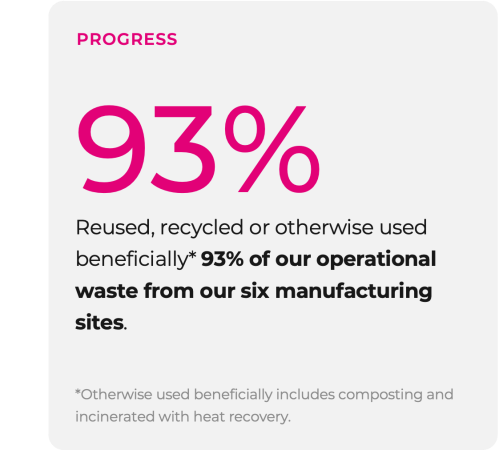Waste management
Effective waste management at our facilities is vital to the communities in which we operate.
Progress on goals
Integrate circular economy principles into our business models by 2050.
By 2025:
- Strive to have 30% of our legacy packaging reviewed against the Organon Sustainability Packaging Guidelines to identify opportunities to reduce our environmental impact.

- Reuse, recycle or otherwise use beneficially* more than 80% of our sites’ operational waste.

Our approach
We continuously strive to reduce the amount of operational waste we generate and maximize the use of environmentally beneficial disposal methods, such as recycling, composting and waste-to-energy. Our Environmental Management Standard requires our facilities to comply with applicable generation, management and disposal regulations, including seeking opportunities to reduce waste at its source, reuse and recycle materials and avoid the use of hazardous materials.
Organon participates in drug takeback and sharps disposal programs in the United States through the Pharmaceutical Product Stewardship Work Group and the MED-Project Product Stewardship Program, which operates community-level pharmaceutical stewardship take-back programs in the United States.

All our manufacturing sites report on different waste streams generated and how they are processed (e.g., reused, recycled, composted, combusted with energy recovery, incinerated or landfilled). Since waste types are defined differently across the globe, we have divided our operational waste into two categories for reporting purposes:
- Hazardous waste: Highly regulated or high-risk waste streams that need to be neutralized, treated or destroyed to address a particular hazard, such as flammability, toxicity, radioactivity, corrosivity, pharmaceutically active or infectious.
- Non-hazardous waste: All other operational waste streams.
Each of our manufacturing sites is responsible for the management of all waste it generates. We track and report waste data quarterly through a centralized environmental data collection (EDC) system. The Environmental Sustainability Center of Excellence consolidates this information to gain insight into the global impact of our waste management activities.
Waste management is also part of our manufacturing sites’ five-year environmental sustainability plans which include short- and medium-term strategies developed to keep us on track to achieve our goal of integrating circular economy principles into our business models.
We collaborate with third-party integrated facility management partners to manage site waste in an environmentally responsible manner. We use only approved waste disposal facilities. We audit the facilities that treat our hazardous waste every four years to ensure they have the systems, technologies and processes in place to manage our waste streams responsibly and in compliance with all applicable requirements.
We continue to evaluate and refine the programs in place at our sites to promote waste reduction and increase reuse and recycling.
Learn more about our operational waste and treatment in our performance data tables in the ESG reporting center
Packaging
The materials we employ to package our finished goods are intended to maintain the physical integrity, efficacy and purity of the final product. In some cases, packaging also provides additional safety features, such as child resistance and tampering protection.
We take the environmental impact of materials into account alongside these features because our packaging eventually becomes our customers’ trash.
We continue to use Organon’s Sustainability Packaging Guidelines which were developed to help our engineers assess and consistently design sustainable packaging. These guidelines focus on the prevention of waste, reduction of packaging materials, recyclability of packaging materials and the use of sustainably sourced materials through the identification and selection of suppliers who share our commitment to sustainability.
Learn more about our work on climate change, water management, and biodiversity